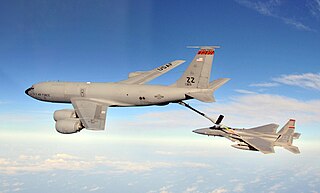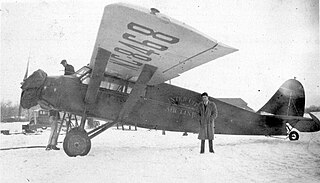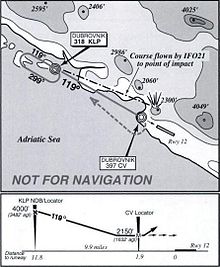
The Boeing KC-135 Stratotanker is an American military aerial refueling tanker aircraft that was developed from the Boeing 367-80 prototype, alongside the Boeing 707 airliner. It has a narrower fuselage and is shorter than the 707. Boeing gave the aircraft the internal designation of Model 717. The KC-135 was the United States Air Force (USAF)'s first jet-powered refueling tanker and replaced the KC-97 Stratofreighter. The KC-135 was initially tasked with refueling strategic bombers, but it was used extensively in the Vietnam War and later conflicts such as Operation Desert Storm to extend the range and endurance of US tactical fighters and bombers.

Tallahassee International Airport is a city-owned airport five miles southwest of downtown Tallahassee, in Leon County, Florida, United States. It serves the state capital of Florida, and its surrounding areas; it is one of the major airports in north Florida, the others being Pensacola, Northwest Florida Beaches, and Jacksonville. Despite its name, it does not service any international destinations.

A non-directional beacon (NDB) or non-directional radio beacon is a radio beacon which does not include inherent directional information. Radio beacons are radio transmitters at a known location, used as an aviation or marine navigational aid. NDB are in contrast to directional radio beacons and other navigational aids, such as low-frequency radio range, VHF omnidirectional range (VOR) and tactical air navigation system (TACAN).

The Boeing T-43 is a retired modified Boeing 737-200 that was used by the United States Air Force for training navigators, now known as USAF combat systems officers, from 1973 to 2010. Informally referred to as the Gator and "Flying Classroom", nineteen of these aircraft were delivered to the Air Training Command (ATC) at Mather Air Force Base, California during 1973 and 1974. Two additional aircraft were delivered to the Colorado Air National Guard at Buckley Air National Guard Base and Peterson Air Force Base, Colorado, in direct support of cadet air navigation training at the nearby U.S. Air Force Academy. Two T-43s were later converted to CT-43As in the early 1990s and transferred to Air Mobility Command (AMC) and United States Air Forces in Europe (USAFE), respectively, as executive transports. A third aircraft was also transferred to Air Force Materiel Command (AFMC) for use as the "Rat 55" radar test bed aircraft and was redesignated as an NT-43A. The T-43A was retired by the Air Education and Training Command (AETC) in 2010 after 37 years of service.
This is a list of aviation-related events from 1996:

Air China Flight 129 (CCA129/CA129) was a scheduled international passenger flight, operated by Air China, from Beijing Capital International Airport to Gimhae International Airport in Busan. On April 15, 2002, the aircraft on this route, a Boeing 767-200ER, crashed into a hill near the airport, killing 129 of the 166 people on board.

The North American Sabreliner, later sold as the Rockwell Sabreliner, is an American mid-sized business jet developed by North American Aviation. It was offered to the United States Air Force (USAF) in response to its Utility Trainer Experimental (UTX) program. It was named "Sabreliner" due to the similarity of the wing and tail to North American's F-86 Sabre jet fighter. Military variants, designated T-39 Sabreliner, were used by the USAF, United States Navy (USN), and United States Marine Corps (USMC) after the USAF placed an initial order in 1959. The Sabreliner was also developed into a commercial variant.
A Combat Systems Officer (CSO) is a flight member of an aircrew in the United States Air Force and is the mission commander in many multi-crew aircraft. The combat systems officer manages the mission and integrates systems and crew with the aircraft commander to collectively achieve and maintain situational awareness and mission effectiveness. CSOs are trained in piloting, navigation, the use of the electromagnetic spectrum, and are experts in weapon system employment on their specific airframe. Aircrew responsibilities include mission planning, mission timing, weapons targeting and employment, threat reactions, aircraft communications, and hazard avoidance.

Janet and Janet Airlines are unofficial names of a highly classified fleet of passenger aircraft operated for the United States Department of the Air Force as an employee shuttle to transport military, DoD civilians, and contractor employees to Special Access Program Facilities (SAPF). The airline mainly serves the Nevada Test and Training Range from a private terminal at Las Vegas's Harry Reid International Airport.

Salé Airport or Rabat–Salé Airport is an international airport located in the city of Salé, also serving Rabat, the capital city of Morocco and of the Rabat-Salé-Kénitra region. It is a joint use public and military airport, also hosting the First Air Base of the Royal Moroccan Air Force. The airport is located about 8 kilometres (5 mi) east-northeast of Rabat and about 90 km (56 mi) northeast of Casablanca.

The 76th Airlift Squadron is part of the 86th Airlift Wing at Ramstein Air Base, Germany. It operates executive airlift aircraft, including the Learjet C-21A and Gulfstream C-37A Gulfstream V.

Pan Am Flight 812 (PA812), operated by a Pan American World Airways Boeing 707-321B registered N446PA and named Clipper Climax, was a scheduled international flight from Hong Kong to Los Angeles, California, with intermediate stops at Denpasar, Sydney, Nadi, and Honolulu. The airplane briefly appeared in the Willy Wonka and the Chocolate Factory movie in 1971. On April 22, 1974, it crashed into rough mountainous terrain while preparing for a runway 09 approach to Denpasar after a 4-hour 20-minute flight from Hong Kong. All 107 people on board perished. The location of the accident was about 42.5 nautical miles northwest of Ngurah Rai International Airport. Until the 1991 Jakarta Indonesian Air Force C-130 crash, it was the deadliest aviation accident to happen on Indonesian soil.

Flying Tiger Line Flight 66 was a scheduled international cargo flight from Singapore Changi Airport to Hong Kong's Kai Tak Airport via a stopover at Kuala Lumpur International Airport, Malaysia. On February 19, 1989, the FedEx-owned Boeing 747-249F-SCD crashed while on its final approach. The aircraft impacted a hillside 437 ft (133 m) above sea level and 12 km from Kuala Lumpur, resulting in all four crew members being killed.

TAME Flight 120 was a Boeing 727-134 airliner, registration HC-BLF, named El Oro, operating as a scheduled international passenger flight between Quito, Ecuador and Cali, Colombia, with a scheduled stopover at the Ecuadorian border town of Tulcán. The aircraft crashed while on approach to Tulcán's Teniente Coronel Luis A. Mantilla International Airport on January 28, 2002. The pilot flew the approach incorrectly in reportedly foggy conditions, and the aircraft crashed into the side of the Cumbal Volcano, located near Ipiales, Colombia, at 10:23 in the morning. All 94 passengers and crew were killed in the crash.

The low-frequency radio range, also known as the four-course radio range, LF/MF four-course radio range, A-N radio range, Adcock radio range, or commonly "the range", was the main navigation system used by aircraft for instrument flying in the 1930s and 1940s, until the advent of the VHF omnidirectional range (VOR), beginning in the late 1940s. It was used for en route navigation as well as instrument approaches and holds.

Air France Flight 117 was a multi-leg international scheduled flight from Paris-Orly Airport via Lisbon, the Azores, Guadeloupe and Peru to Santiago, Chile, which crashed on 22 June 1962. The Boeing 707–328 aircraft involved in the accident was just four months old.
This is a list of aviation-related events from 2010.

Transbrasil Flight 303 was a flight from Congonhas-São Paulo Airport in São Paulo, Brazil, to Hercílio Luz International Airport in Florianópolis, Brazil, on 12 April 1980. It crashed on approach to Hercílio Luz International Airport. Only 3 of the 58 people on board survived.

1931 Jinan Air Crash occurred on November 19, 1931, when a Stinson Detroiter mail plane carrying one passenger and two pilots crashed into a mountainous area in Jinan, Shandong Province, China. All three people on board, including the only passenger, Chinese poet Xu Zhimo, died in the crash.



















